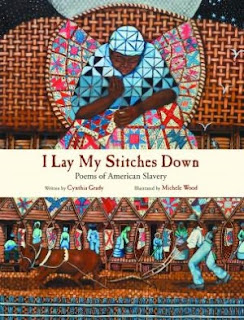Last year, my fourth graders read a lot of poetry. And did a lot of science. Some of the best poetry that they wrote integrated their love of poetry with their learning about science. As I think about that experience, I wonder how teachers might include more poetry into work in the content areas. I have been on the lookout for books that integrated poetry, science, and social studies.
This month, I came across I LAY MY STITCHES DOWN, a collection of approximately 15 poems, each told through the voice of a slave. The book was written by poet and quiltmaker, Cynthia Grady, who introduces the book, saying:
"Quiltmaking and poetry share similarities in craft. In one, color and shape are organized into an overall pattern; in the other, sound and structure create the pattern. Each poem in this collection is named for a traditional quiltblock and reflects a metaphorical patchwork of circumstances encounter by enslaved people in America…Grady's poems capture a variety of voices, including field workers, slave children, runaways, a slave who has just been beaten and a mother who has just watched her daughter sold away.
To reflect the three layers of a quilt, I've engage three references in each poem: a biblical or spiritual reference, and a sewing or fiber arts reference in addition to the imagery the poem calls for…
UNDERGROUND RAILROAD
Like a hyena on the hunt, you know,
he opportunistic, unspecialized.
The bounty hunter prowl the riverbank.
He use the wind to his advantage and
he listen: he watch intently. A slave
to greed, the hunter aine no match fo rthis
old pilgrim in the woods. He don't quite hear the owl that call my name to take me to
the water where the current runs less swit.
I wait-- then thread my way to freedomland.
SCHOOLHOUSEEach two-page spread is organized in a similar fashion. The top portion of the left hand page displays the poem, titled after a quilt pattern, and set on a white background. A colorful quilted strip, in the pattern of the title, separates the poem from the bottom portion of the page, which contains historical information about slavery, or the song reference, or other information that might be helpful to the reader.
Each morning after walking Little Miss
to school, we steal away beneath the oak
to piece together everything we hear.
The teacher catch us making letters in
the dirt with sticks one day. Her eyes go wide
and icy blue. She walk away. We fear'd
our backs would get the rawhide stich. Instead,
she twitch the curtain at the window, teach
her lessons loud and clear-- her voice, a prayer
with wings. It give us hope; it sing us home.
The right hand side of the page is a full-color oil painting by Michele Wood, who does an amazing job capturing the image contained in the words against a colorful background of quilts and patterns. I would love to have one of Wood's beautiful illustrations hanging in my living room.
Intermediate and adolescent readers might not understand this book, left to their own devices. However, it's definitely a book that could be read aloud and appreciated within the context of a unit on slavery or African American history. I know it's one I will be using with older readers.

1 comment:
Late, but wanted you to know I enjoyed reading about this book, Carol. I have a friend who is a quilter who will love it, plus also good for our library. Have a Merry Christmas with your boys!
Post a Comment